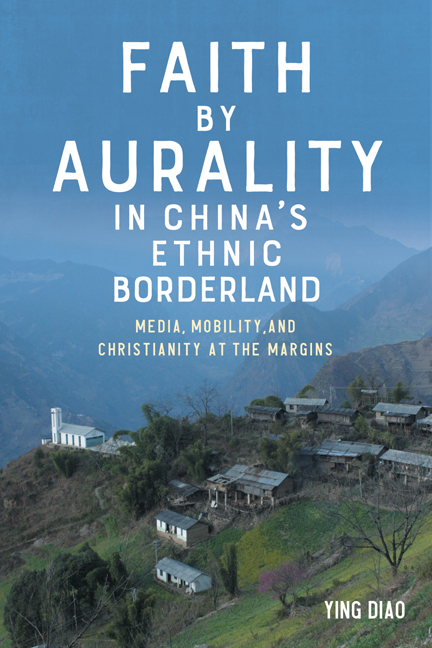Book contents
- Frontmatter
- Dedication
- Contents
- Acknowledgments
- Notes on Romanization and Terminology
- Introduction
- 1 Becoming the Faithful: Cleanliness and Conversion
- 2 Hearing the Return of Faith: Radio and Listening Audience
- 3 Producing Gospel Songs: Studio and Media Practitioners
- 4 Faces and Places: Sounds That Recognize
- 5 Traces of Faith: Sound Artifacts and Infrastructures
- 6 Performing Recorded Songs: Religiosity by Body
- 7 Hidden Faith: Sanitizing the Voice
- Conclusion: Faith on the New Frontier
- Appendix 1 Glossary of Old Lisu
- Appendix 2 Glossary of Chinese Characters
- References
- Index
6 - Performing Recorded Songs: Religiosity by Body
Published online by Cambridge University Press: 15 May 2024
- Frontmatter
- Dedication
- Contents
- Acknowledgments
- Notes on Romanization and Terminology
- Introduction
- 1 Becoming the Faithful: Cleanliness and Conversion
- 2 Hearing the Return of Faith: Radio and Listening Audience
- 3 Producing Gospel Songs: Studio and Media Practitioners
- 4 Faces and Places: Sounds That Recognize
- 5 Traces of Faith: Sound Artifacts and Infrastructures
- 6 Performing Recorded Songs: Religiosity by Body
- 7 Hidden Faith: Sanitizing the Voice
- Conclusion: Faith on the New Frontier
- Appendix 1 Glossary of Old Lisu
- Appendix 2 Glossary of Chinese Characters
- References
- Index
Summary
To one convention held in the Christmas of 1968 on the Myanmar-Indian border:
Each village came with its own choir, which had been practicing special songs for the occasion. Each group had an opportunity to sing in one or more of the seven services held during the convention… . This great service, with hundreds of joyful voices harmonizing in old hymns like “What a Friend We Have in Jesus” and “Amazing Grace,” was a true feast to God—a feast of music.
—E. Morse 1974, 180Individual activities were hard to comprehend in the lively and bustling context of a Lisu village. From a Christian standpoint, the strongest practices were those that could be done together, that expressed the communal life of the Body of Christ: gathering together to practice line dancing, attending church, singing in four-part harmony, and participating in intercessory prayer meetings.
—Arrington 2020, 147May 25, 2014—The new chapel of Nongchang Church, Lushui County
I am sitting at the back row in order to have a better view of the congregation seated in front of me. I expect a lengthier time at today's Sunday noon service, as it will be combined with the dedication ceremony of the new church building (hinshir ddutbair). I know it because students of the Nujiang Christian training center have been rehearsing two dance performances for this special occasion. Although the ceremony is organized by and for the host Nongchang Church, churches in close proximity and from afar are invited to celebrate together the growth of the local faith community. Every seat (around three-hundred capacity) in the chapel is occupied and still a large crowd of several hundred others is standing on three sides of this open space, all looking onto the central podium. After congratulatory speeches, a short sermon, and an enthusiastic church fundraiser—the collec-tion box is passed around and people just throw money into the box—the presider announces the beginning of the praise time (xelgget rriq).
The presider has received piles of paper strips, indicating that several dozen performances have been lined up for the next couple of hours. Participants from the invited churches are welcome to perform as many songs as possible. I often recognize the familiar melodies of mostly Burmese origin that I have heard in other mass gatherings or through recordings.
- Type
- Chapter
- Information
- Faith by Aurality in China's Ethnic BorderlandMedia, Mobility, and Christianity at the Margins, pp. 143 - 166Publisher: Boydell & BrewerPrint publication year: 2023

